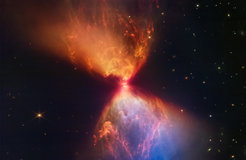Semi-heavy water ice detected around young Sun-like star
For the first time, a team at Leiden University led by Ewine van Dishoek, an external scientific member of MPE, has robustly detected semi-heavy water ice around a young, sun-like star. These results support the theory that some of the water in our solar system originated before the Sun and its planets formed. The researchers used the James Webb Space Telescope to make their discovery, which they have published in The Astrophysical Journal Letters.
One way astronomers trace the origin of water is by measuring its deuteration ratio. Deuterium is a stable isotope of hydrogen whose nucleus contains a neutron as well as the proton. Water composed of one deuterium atom and one hydrogen atom – HDO rather than H₂O – is also known as semi-heavy water. A high fraction of semi-heavy water indicates that the water formed in a very cold place, such as the primitive dark clouds of dust, ice, and gas from which stars are born.

In our oceans, comets, and icy moons, up to one in a couple of thousand water molecules consists of semi-heavy water. This is about ten times higher than expected based on the composition of the Sun. Therefore, astronomers hypothesise that some of the water in our solar system originated as ice in dark clouds hundreds of thousands of years before the birth of the Sun. To confirm this, they must measure the deuteration ratio of water ice in star-forming regions.
An international team of astronomers has now detected a high ratio of semi-heavy water ice in a protostellar envelope. This is the cloud of material surrounding a star in its embryonic stages.
The astronomers used the James Webb Space Telescope. Prior to its launch, the water deuteration ratio in star-forming regions could only be reliably measured in the gas phase, where chemical alteration occurs."Now, with the unprecedented sensitivity of Webb, we observe a beautifully clear semi-heavy water ice signature toward a protostar," says Katie Slavicinska, the Leiden University (Netherlands) PhD student who led the study.
The L1527 water deuteration ratio is very similar to that of some comets, as well as to the protoplanetary disk of a more evolved young star. This suggests that the water found in all of these objects has similar cold and ancient chemical origins.
"This finding adds to the mounting evidence that the bulk of water ice makes its journey largely unchanged from the earliest to the latest stages of star formation," says co-author Ewine van Dishoeck, a professor of astronomy at Leiden University who has spent much of her career tracing the journey of water through space.












